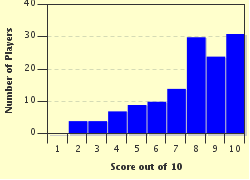Quiz Answer Key and Fun Facts
1. Which popular spiced bun, named after the area of London where it was first produced in the 18th century, is produced by rolling up dough spread with a mixture of butter, sugar and currants?
2. A flat, round cake made with flaky pastry and stuffed with currants is often given the rather unappetising name 'squashed fly cake'. By what name is it better known?
3. One particularly famous British tart consists of a short-crust pastry case lined with jam and filled with frangipane and, in some variations, topped with fondant icing and half a glacÚ cherry. Contrary to some expectations, it is not named after a requirement of its cooking process, but after which market town in Derbyshire?
4. A rich fruit cake, usually topped with a distinctive circular pattern of almonds, is named after which Scottish city?
5. Scotch pancakes are generally smaller and thicker than English pancakes or French crepes and more closely resemble the American and Canadian versions of this popular treat. By what other name are they generally known - particularly in parts of Scotland?
6. Shrewsbury cakes (also known as Shrewsbury biscuits) date back to at least the 17th century and are a traditional food from which English county?
7. Welsh cakes are also known as bakestones in Wales as they are traditionally cooked on a 'bakestone'. Which of the following best describes a Welsh cake?
8. The Bath bun is a sweet roll, often including various dried fruits and a sugar cube pressed into the bottom of the mixture. Its invention is commonly attributed to which 18th century physician, who also created a type of dry biscuit that carries his name?
9. Despite its name, Kendal mint cake is not really a cake! What are the four main ingredients used in its production?
10. A 19th century Quaker by the name of Henry Chalkley is credited with inventing a simple sponge cake with pink icing that could be easily mass produced and sold cheaply. After which area of London is this cake named?
Source: Author
Fifiona81
This quiz was reviewed by FunTrivia editor
WesleyCrusher before going online.
Any errors found in FunTrivia content are routinely corrected through our feedback system.

